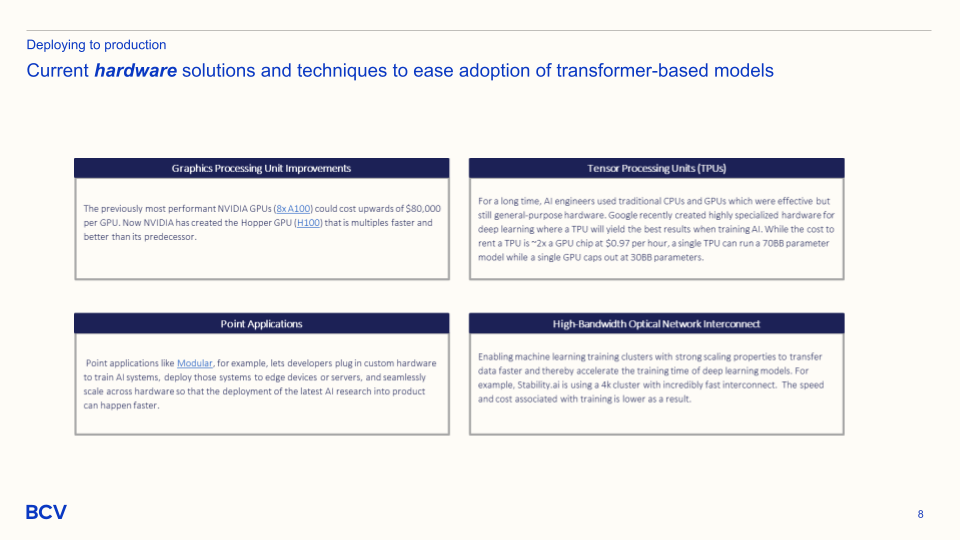
Selective State Space Models: Solving the Cost-Quality Tradeoff
As AI is increasingly used in production scenarios, costs are mounting. Are alternative architectures the solution?



We couldn’t have said it better ourselves. We’re living in a special time; we have the compute, funding, and expertise to augment wide swaths of knowledge work using foundation models (also referred to as large language models or LLMs in NLP use cases). But despite their near-magical characteristics, foundation models aren’t yet ready for primetime. They are still held back from practical usage due to a variety of technical constraints.
Before we get into the weeds, let’s cover what makes foundation models, well, foundational.

These are exciting developments, made possible by the transformer architecture, which couples a block of encoders and decoders through a self-attention mechanism. It has become the state-of-the-art approach for self-supervised pre-training in NLP and sequence learning. Put very simply, self-attention enables the model to maintain an understanding of the relationship between every position in the input and output sequences. The encoder converts the input sequence into a set of vector embeddings, which are long strings of numbers to represent natural text that the model can reason about. The decoder converts the embeddings into a different sequence of words, or an image, or some other modality.
A transformer model’s ability to process the entire input all at once has less complexity and compute cost relative to legacy neural networks (i.e. RNNs). Prior approaches had narrower attention mechanisms, harming model performance. The result has been the rapid development of a series of LLMs that can more accurately perform tasks across text generation, image generation, code generation, summarization, translation, and much more.

Smaller AI companies have a structural disadvantage competing against incumbents due to both computational intensity and the increased data volume advantage that scale brings. Almost without exception, initial foundation models came from the largest technology companies: Google, Facebook, OpenAI (funded by Microsoft), and NVIDIA. We expect the cost of training, configuring, and running foundation models to increase as models grow in parameter size, data advantages incentivize more creative data extraction techniques, and chip shortages continue to exacerbate compute innovation and capacity. Today, well-funded startups like OpenAI and Adept, large corporations like Microsoft and Google, and research groups at top universities lead model R&D and drive the pace of new breakthroughs.


Productionization, as many ML engineers know, is a trade off between complexity and cost, but often an unavoidable amount of both. Most ML projects fail before they get to production. We are optimistic that proof of concept complexity will decrease in the coming years, as products like ChatGPT unlock the imagination of everyone from software engineers to people-ops leaders. Downstream, model fine-tuning is reliant on curating large swaths of unstructured enterprise data. Optimizing training latency and cycle time is an outsized opportunity, given model scale and complexity. Users demand that modern applications be highly interactive, and as “real-time” as possible, increasing emphasis on data streaming platforms.

While the primary axis of competition so far has been parameter size, the research community is increasingly focusing on new optimization techniques to make models easier to train, use, and deploy with greater accuracy. One such example is DeepMind’s Chinchilla, which has ~4x fewer parameters, but was trained on ~4x more data than Gopher and could perform at parity. Consequently, we believe large models are severely undertrained, suggesting that we’re not compute constrained, but rather data constrained. (Andrew Ng continues to be correct about data-centric ML!)

One newer approach to model optimization is sparse activation (e.g. Google Pathways architecture), which avoids activation of the entire neural network and instead activates very specific pathways as needed, reducing compute waste.

Earlier, we mentioned that transformers use self-attention to simultaneously track the relationship between each input position and output position. This scales quadratically with sequence length, contributing to much higher training costs with larger sequences. However, in many production use-cases, larger sequence lengths are needed to appropriately train and specialize models for specific contexts. Not to mention, larger sequence lengths create a new set of training opportunities for large models.
Tri Dao and Chris Re at Stanford have done a tremendous job with Flash Attention, which gives attention mechanisms IO-awareness, enabling them to account for the cost of reads and writes between various tiers of GPU memory and then using tiling (exploiting locality) and backward attention to be more efficient. The memory demand is nearly 5-20x lower, with 2-4x faster execution than those of exact attention mechanisms. Jason Brown and Yiren Zhao of Cambridge posit Wide Attention as another optimization over exact attention, where models are made shallower (fewer layers) with greater number of attention heads per layer, and found performance gains. Knowledge distillation, or using a pre-trained model to train a new model, is also seeing promising results, e.g EleutherAI’s Pile or DeepMind’s ZeRO. This technique avoids the dead weight of the original model, plus removes a key GPU memory barrier to building models with trillions of parameters.

At the hardware layer, we are seeing a transition from CPUs to GPUs to TPUs, which are more efficient for training massive (30B+ parameter) models. GPUs themselves are becoming multiples faster and cheaper, in part thanks to decreased demand from the crypto-mining sector, though some geopolitical and supply-chain constraints remain. Finally, higher bandwidth optical interconnects are emerging to power ML training clusters, addressing a network bottleneck.

We see great opportunity at every layer of the foundation model value chain, and are most bullish on the following five trends.
At BCV, we’ve been lucky to partner with category-creating entrepreneurs at the forefront of NLP and ML. If you’re thinking about or building in this space, we’d love to meet you. Drop us a line at rgarg@baincapital.com, scrowder@baincapital.com, or dheck@baincapital.com.
As AI is increasingly used in production scenarios, costs are mounting. Are alternative architectures the solution?
Cube is the standard for providing semantic consistency to LLMs, and we are investing in a new $25M financing after leading the seed round in 2020.
In this edition of “In the Lab,” Amit Aggarwal explains why he’s building an AI startup in BCV Labs after selling his company The Yes to Pinterest.